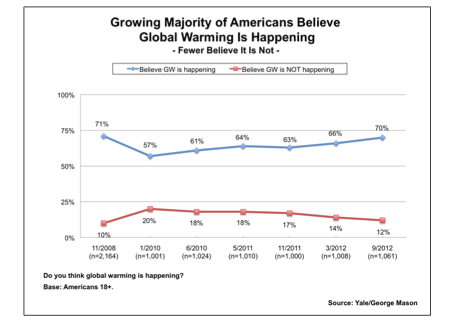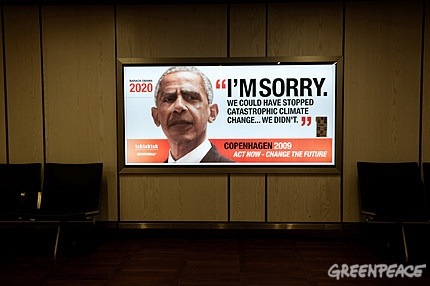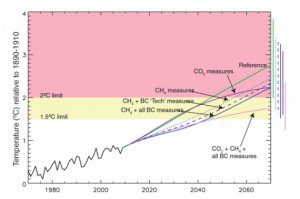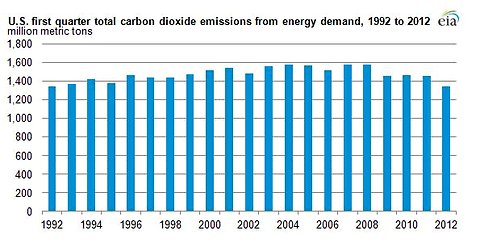Huzzah! Barack Obama in his re-election night valedictory speech finally acknowledged that climate change is a problem we may have to attend to:
We want our children to live in an America that isn’t burdened by debt, that isn’t weakened by inequality, that isn’t threatened by the destructive power of a warming planet.
I seem to recall that candidate Obama said something audacious calling on the global community to prevent the oceans from rising and to save the planet. After four years of America’s sausage grinders whittling away at hope and change, can the president finally deliver measures to address climate change? Does he still want to?
After Hurricane Sandy, I wrote two posts (here, here) about whether climate change had anything to do with the storm. As I noted, whatever the causal connections, the hurricane has brought renewed attention to the problem, an opening that advocates have to take advantage of while the policy window is open. With climate change back on the domestic agenda and global climate negotiations beginning this week in Doha at the moment, what should be done?
The President’s Intent
In his post-election valedictory press conference, President Obama was asked about what he intended to do about climate change in his second term and whether or not he would propose a carbon tax. He gave the environmental community some cause for optimism:
But we haven’t done as much as we need to. So what I’m going to be doing over the next several weeks, next several months, is having a conversation, a wide-ranging conversation with scientists, engineers and elected officials to find out what can — what more can we do to make short-term progress in reducing carbons, and then working through an education process that I think is necessary, a discussion, the conversation across the country about, you know, what realistically can we do long term to make sure that this is not something we’re passing on to future generations that’s going to be very expensive and very painful to deal with.
Even before environmentalists could speculate much about the president’s intentions, Obama poured some cold water on how much his administration might be willing to do. He then suggested that he wasn’t sure the American political establishment had any appetite for new policies and that climate change would (surprise!) take a back seat to America’s economic recovery:
I don’t know what — what either Democrats or Republicans are prepared to do at this point, because, you know, this is one of those issues that’s not just a partisan issue. I also think there’s — there are regional differences. There’s no doubt that for us to take on climate change in a serious way would involve making some tough political choices, and you know, understandably, I think the American people right now have been so focused and will continue to be focused on our economy and jobs and growth that, you know, if the message is somehow we’re going to ignore jobs and growth simply to address climate change, I don’t think anybody’s going to go for that. I won’t go for that.
The president’s spokesman Jay Carney was even more direct the following day:
We would never propose a carbon tax, and have no intention of proposing one.
The Politics
So that leads me to wonder what the agenda should be for activists aiming to influence the tenor of the administration’s climate policies at home and abroad in the second term (my Duck colleague Rodger Payne has mused in recent days about how to frame such efforts).
The president already can lay claim to some modest successes on climate policy relating to new vehicle efficiency standards as well as some now controversial investments in clean energy. There does appear some potential for bipartisan support for an extension of the tax credits for wind energy. However, this appears to be pretty small ball stuff, nothing on its own that would change the essential price signals in favor of low-carbon energy sources.
In terms of domestic legislation, the political challenge is as it always has been: finding enough votes for a policy that will put a price on carbon in a significant way. I worry that in the absence of a Democratic majority in the House, no legislative possibilities, save for wind tax credits, are likely available.
Leaving the House aside for the moment, getting legislation through the Senate normally requires two things (1) keeping enough Democrats, including from key energy states, on board and (2) attracting enough Republican votes to prevent a filibuster. The Democrats have 55 seats after the 2012 elections (if you include Independents Sanders-VT and King-ME caucusing with them). That means that you need an additional five Republicans to vote with the Dems on legislation to cut off debate. However, in practice, it probably means a few more Republicans would be needed, if you think some climate-hostile Democratic Senators like Mancin of West Virginia, Landrieu of Louisiana, and possibly some Western state Democratic Senators might be pretty firm no’s.
Looking back, cap-and-trade legislation (where firms would face an absolute cap in the amount of greenhouse gas emissions they could generate but could trade emissions permits to others if they were able to generate less than their allotment) was seen as an essential compromise because it was regarded as the most likely policy to attract some number of Republican votes in the Senate. Indeed, the pedigree of cap-and-trade was as a thoroughly Republican idea emanating from the experience of the George H.W. Bush administration with the the Clean Air Act.
I believe the hope was that cap-and-trade might be palatable if paired with some other compromises on nuclear energy and off-shore oil drilling. As I argued here before, the Fukushima and Deep Water Horizon disasters took those concessions off the table.
Climate denialism has so permeated the Republican Party in the last five or six years that cap-and-trade has been elevated to a partisan signifier. Republicans dismiss cap-and-trade legislation as part and parcel of a broader conspiracy to elevate what they false see as a non-problem.The idea has been so vilified that it is no longer available as a bipartisan compromise.
However, we have to remember that not so long ago in the face of rising public worry post-Katrina that Republican governors around the country supported action on climate change, including regional cap-and-trade schemes. Can we get back to something like that?
The Options
In the wake of the election and Hurricane Sandy, there is now more political pressure to do something on climate change than there has been for five years. While the weakness of the American economy poses a continued drag on policymakers’ willingness to engage on climate change, the spate of extreme weather that the United States has experienced over the past few years, including epic droughts and floods, has steeled public opinion. After having been bombarded with negative information, the American public is returning to previous form and once again is largely convinced that climate change is real and that something should be done (We have to be careful to not overstate their interest. Republicans are still pretty split about climate change, and the climate probably still is likely to be somewhat lower down on people’s priorities but still…)
Carbon Tax? There has been some renewed interest in a carbon tax as a more transparent way of putting a price on carbon and one that might attract Republicans. Normally, such an idea would be anathema to Republicans in light of Grover Norquist’s anti-tax pledge, but that allergy among Republicans may be on the wane.
A carbon tax has created some minor buzz among wonks, particularly if paired with a payroll tax reduction to be revenue neutral. A carbon tax could also partially be used to raise revenue for deficit reduction if there were some new room for a grand bargain on entitlements reform. A former Republican Congressman Bob Inglis of South Carolina, who nows runs a center at George Mason, has been a vocal advocate on the right for this solution (David Roberts of Grist magazine raises a number of useful questions about what happens to the revenue, how much of an incentive for cleaner energy would come from it, how much the poor would be hurt, etc.)
In light of the president’s comments, however, a carbon tax is not an idea whose time has yet come. The president would likely only embrace such a policy if there was a constituency demanding action. Until recently, the environmental community was relatively quiescent, tamping down on its criticism in the midst of the president’s re-election fight.
Oppose Keystone XL?
With the election now out of the way, environmentalists are now vocal again. Among the loudest voices is activist Bill McKibben who is touring the country in sold-out venues and leading the charge to oppose the Keystone XL pipeline, a pipeline that would bring oil from the Canadian tar sands to be refined in Texas. President Obama deferred the Keystone decision until after the election, and environmentalists are rallying to have him reject the pipeline. Their underlying logic is based on McKibben’s Do the Math tour and a recent piece he penned for Rolling Stone magazine. As McKibben notes, there are far more hydrocarbons in the ground (2795 gigatons worth) than can be emitted without crossing the 2 degrees Celsius threshold that scientists say is necessary to avoid unacceptable damage from climate change (about 565 gigatons worth of greenhouse gases can be released by midcentury to keep the climate within 2 degrees Celsius).
As a recent World Bank report noted, at current rates of emissions growth, we may be closer to 4 degrees Celsius (7.2 degrees Fahrenheit) by century’s end. A PricewaterhouseCoopers report warned of a similar result and suggested that rates of decarbonisation of the economy would have to accelerate dramatically to achieve the 2 degrees goal:
Our Low Carbon Economy Index evaluates the rate of decarbonisation of the global economy that is needed to limit warming to 2oC. This report shows that global carbon intensity decreased between 2000 and 2011 by around 0.8% a year. In 2011, carbon intensity decreased by 0.7%. The global economy now needs to cut carbon intensity by 5.1% every year from now to 2050. Keeping to the 2oC carbon budget will require sustained and unprecedented reductions over four decades.
What this means is that some carbon-based fuels will have to stay in the ground, including possibly the tar sands of Canada. As Michael Levi suggested, building the pipeline doesn’t mean that all of the tar sands will ultimately be burned. Later decisions on pricing carbon might mean that only a portion of them actually get used. Moreover, in the absence of many short-run options on transportation fuels, the world will still need access to some hydrocarbons.
A negative project to cancel Keystone may do little to jumpstart alternative transport fuels and merely mean that oil is pumped from some other less politically salient location. (Moreover, in the absence of major new interventions in terms of innovation and efficiency, rising demand from Asia for transportation and electricity will dwarf anything we do. As Andrew Revkin pointed out, of 1200 new coal burning power plants that are being planned, two thirds of them are in Asia.)
Climate activists will say that we have to start somewhere and change the strategic incentives facing those seeking to get new carbon-based fuel sources out of the ground. I just wonder if opposing individual pipelines is the best use of limited advocacy energy and time. This decision may soon be moot, as many expect Obama to approve the pipeline in any case.
Maybe, as I previously argued, the radicals will make the policy asks by the moderates look more attractive, but the history of climate activism thus far suggests to me that the U.S. environmental community needs to rally around something achievable, which requires figuring out how to unlock moderate Democratic and Republican opposition.
Here, my proclivities are more in tune with Michael Levi who shortly after the election wrote:
All of this means that you need to do considerably more than block oil and gas development if you want to really bend the U.S. emissions curve. What you need is to go directly after emissions from U.S. fossil fuel consumption in a big way, whether that’s through an explicit price on carbon, a clean energy standard, or something else. And since that eventually requires action from Congress, you need to build coalitions. I’m not suggesting that advocates for climate action need to satisfy every member of the House and Senate. But really big steps will eventually require collaboration that extends far across party lines – and putting together coalitions in this vein will inevitably require some support for U.S. oil and gas.
Other options?
Where does all this leave us? While the maths of emissions trajectories suggest that further compromise is dangerous, I wonder if the president can make Keystone approval contingent upon or tied to progress on further measures on energy efficiency and decarbonisation. As Levi argued, activist opposition to Keystone and other sources of domestic oil and gas production can increase advocates’ bargaining leverage. However, if activists hold opposition to all new oil and gas production as non-negotiables, then they may end up with nothing.
While McKibben may be less inclined to support a deal than other environmentalists, I’m actually confident that the leading environmental groups like NRDC, C2ES, EDF, and WRI among others would rally behind a consensus if one could be found. The challenge for both these groups and the president is figure out what the core policy ask is going forward and not to make early, unnecessary concessions.
This was the knock against the President Obama’s clumsy efforts to engage Republicans like South Carolina’s Lindsey Graham in the lead up to failed efforts in 2009 to push a cap-and-trade bill. In that go around, the president preemptively made concessions giving little incentive for Republicans to compromise (I actually think that the timing was bad and that any effort was doomed to fail).
So what might actually be part of that core, if not a carbon tax. Michael Levi as well as David Victor et al. suggest that an effort on short-term gases like methane and black carbon (soot) could change the trajectory of greenhouse gas concentrations sooner rather than later. They are potent greenhouse gases and are low-hanging fruit both at home and internationally (here, Levi cites a paper by Shindell et al that suggests the arc of temperature impacts is more immediate from action on these gases compared to carbon dioxide).
Indeed, the Obama administration has already initiated an international process to reduce short-term gases so the question remains what needs to be done to ensure adequate implementation. Here, it’s unclear what if anything is needed from Congress, though appropriations may be required. The initial call was for a paltry $10 million.
Still, if we are exclusively relying on Congressional action, we may be waiting in vain (unless the 2014 mid-terms miraculously turf out even more Republicans in the House). I think many in the environmental community such as former Obama official Nat Keohane (now back with EDF) are hoping that the administration can use executive orders, the president’s good offices, and existing legislative authority to pursue further breakthroughs on energy efficiency and regulating greenhouse gases. Some of these are more politically contentious than others.
We should remember that the Obama administration achieved enhanced fuel efficiency standards as part of a voluntary agreement with the automobile industry (he might have had a little leverage after the auto bailouts). Can further breakthroughs in efficiency standards for appliances and buildings be achieved in a similar fashion?
Other policies like the EPA ability to regulate carbon under the Clean Air Act have been contested and upheld in the Courts with the decision punted until next year. If the Administration gets serious about climate change as it should, using existing EPA authority would be a major next step, and the only likely measure that the administration can credibly promise to use that might prompt preemptive Congressional action.
Conclusion
While global emissions continue to rise, U.S. emissions have gone down. As one study noted, the U.S. may actually be able to achieve the pledge made before the 2009 Copenhagen climate negotiations to reduce its greenhouse gas emissions 17% below 2005 levels (or 4% below 1990 levels) by 2020.
It’s actually quite amazing because even in the absence of comprehensive climate legislation, U.S. emissions of greenhouse gases have come down to a 20 year low, partially a function of mild winters, low natural gas prices (which have prompted fuel switching from coal to gas), and lower economic activity but also due to vehicle emissions standards and state level policies. Imagine what might be possible if we were actually trying!
I have said little about what should be done internationally so once the ball gets rolling in Doha, I’ll come back to this blog to say a bit more about how the international climate agenda should unfold going forward.
Joshua Busby is a Professor in the LBJ School of Public Affairs at the University of Texas-Austin. From 2021-2023, he served as a Senior Advisor for Climate at the U.S. Department of Defense. His most recent book is States and Nature: The Effects of Climate Change on Security (Cambridge, 2023). He is also the author of Moral Movements and Foreign Policy (Cambridge, 2010) and the co-author, with Ethan Kapstein, of AIDS Drugs for All: Social Movements and Market Transformations (Cambridge, 2013). His main research interests include transnational advocacy and social movements, international security and climate change, global public health and HIV/ AIDS, energy and environmental policy, and U.S. foreign policy.





0 Comments